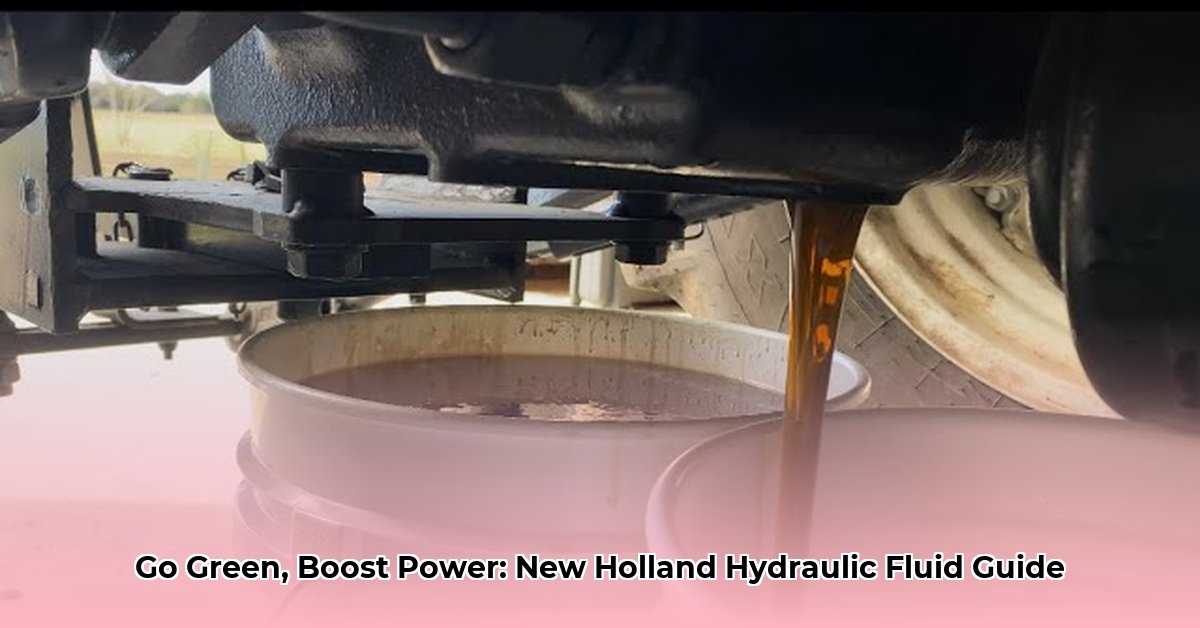
Maintaining your New Holland tractor's hydraulic system is crucial for both peak performance and environmental responsibility. This guide provides a comprehensive, step-by-step approach to selecting, using, and disposing of hydraulic fluid sustainably, ensuring your tractor runs smoothly while minimizing your environmental impact. For additional resources on New Holland tractors, check out this helpful website.
Choosing the Right Hydraulic Fluid for Your New Holland Tractor
Selecting the appropriate hydraulic fluid is paramount. The wrong choice can lead to reduced performance, costly repairs, and even system failure. Your New Holland's owner's manual is your primary reference; it specifies the manufacturer's recommended fluid type and viscosity. However, understanding the different fluid types and their properties will help you make informed decisions.
Factors to Consider:
- New Holland Tractor Model: Consult your owner's manual for precise fluid recommendations. Using the incorrect fluid can void your warranty.
- Operating Conditions: Extreme temperatures (both high and low) and heavy workloads demand fluids with enhanced performance characteristics. Heavy-duty operations may require synthetic fluids for extended lifespan and resistance to degradation.
- Fluid Type: Several types are available, each with varying properties and environmental impacts:
- Mineral-Based: Affordable and widely available, but less performant in extreme temperatures and with a moderately higher environmental impact than other options.
- Synthetic: Offer superior performance, extended lifespan, and better resistance to extreme temperatures. While more expensive upfront, their longer lifespan often offsets the initial cost. Their environmental impact is generally lower than mineral-based fluids, varying depending on the specific formulation.
- Bio-based: Made from renewable sources and designed to be biodegradable, these fluids are increasingly popular for their reduced environmental footprint. Performance in extreme conditions may be limited compared to synthetics, and compatibility with your New Holland model needs verification.
| Fluid Type | Pros | Cons | Environmental Impact | Best Suited For |
|---|---|---|---|---|
| Mineral-Based | Cost-effective, widely available | Lower performance in extremes, shorter lifespan | Moderate | Mild climates, light-duty operations |
| Synthetic | Superior performance, extended lifespan, higher temp resistance | Higher initial cost | Lower (variable) | Diverse conditions, heavy-duty operations, extreme temperatures |
| Bio-based | Renewable, biodegradable, environmentally friendly | May have performance limitations in some conditions, potentially higher cost | Low | Environmentally conscious users; check for model compatibility |
Isn't it crucial to understand the environmental impact of each fluid before making a choice? Yes, absolutely! Prioritizing bio-based options wherever feasible significantly reduces your carbon footprint.
Performing a New Holland Tractor Hydraulic Fluid Change: A Step-by-Step Guide
Regular fluid changes are critical for optimal hydraulic system performance and longevity. Follow these steps carefully, always referring to your owner's manual for model-specific instructions.
Preparation: Gather necessary tools: drain pan, new filter (if applicable), funnel, new hydraulic fluid, wrenches, and safety gear (gloves and safety glasses). Consult your owner's manual for fluid quantity.
Draining the Old Fluid: Position the drain pan securely under the drain plug. Slowly loosen and remove the plug, allowing the fluid to drain completely. Caution: The fluid may be hot.
Filter Replacement (if applicable): Replace the hydraulic filter according to the manufacturer's instructions.
Refilling: Carefully pour the correct amount of fresh hydraulic fluid into the reservoir using a funnel. Avoid overfilling.
Checking Fluid Levels: Start the tractor and run the hydraulic system briefly. Check the fluid level again and top off if necessary.
Proper Disposal: Never dump used hydraulic fluid. Contact your local waste management facility or recycling center for proper disposal methods. Did you know that responsible disposal can significantly reduce environmental contamination?.
Troubleshooting Common Hydraulic System Issues
While regular maintenance minimizes problems, some issues might arise.
Leaks: Address leaks immediately. Identify the source and repair or replace components as needed.
Contamination: Contaminated fluid compromises system performance. Regular filter changes are crucial.
Performance Issues: Sluggish response, unusual noises, or other performance problems warrant immediate attention by a qualified mechanic.
Overheating: This may indicate issues with the cooling system or the hydraulic fluid itself. Ensure adequate airflow and address any potential leaks contributing to fluid loss.
Sustainable Practices for Minimizing Environmental Impact
Responsible fluid management extends beyond regular changes:
Extend Fluid Change Intervals (Where Possible): High-quality fluids, especially synthetics, offer extended lifespans, reducing the frequency of fluid changes. Always follow your owner's manual recommendations.
Recycle Used Fluid: Properly dispose of used fluid through approved channels.
Explore Bio-based Alternatives: Investigate bio-based options compatible with your New Holland model. Transitioning to such fluids significantly reduces the environmental impact.
Prevent Spills: Employ careful handling practices during fluid changes to prevent spills and contamination.
By following this guide, you ensure both the efficient operation of your New Holland tractor and a smaller environmental footprint. Remember, proactive maintenance and responsible disposal are key to long-term sustainability.